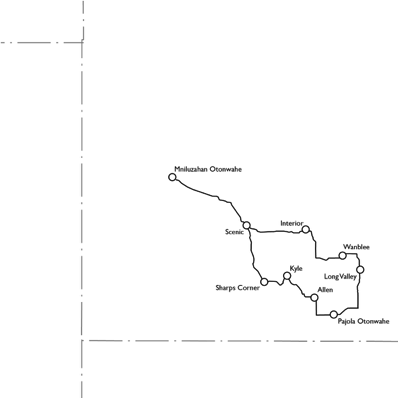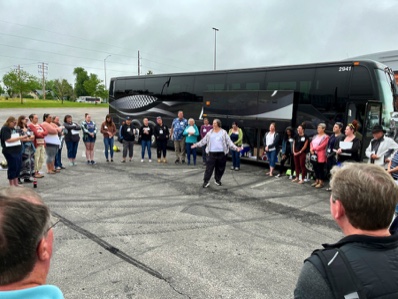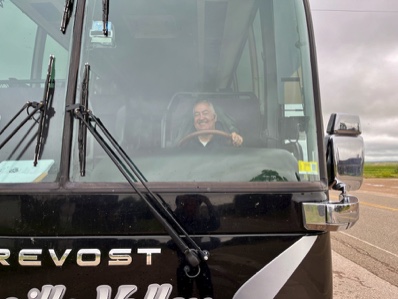. . . and innovative projects . . .
Itinerary
Depart Rapid City for Scenic then continue south to Sharps Corner. Head east to the Lakota ArtSpace and on to Kyle. From there, drive through Yellow Bear Canyon en route to Allen. Continue on to Martin for lunch and an allotment activity. Back on the bus, take the Long Valley route to Wanblee and continue on to Interior and back to Scenic and Rapid City.
Anpetu Zaptan, Day Five





Photos
Sunwise from top-left: Stacy sharing woyaksape before we all boarded the bus. The CAIRNS team of Jo, Lacy, and Mabel (Right to Left). Here the team is preparing to serve snacks and coffee on the road. Helene Gaddy visits in her gallery space. And thats our driver, Ray.
"Black Elk, A Man of Two Worlds" by Joseph Bodeson (a seminar attendee)
This is the story of a great spiritual leader. This brief introduction to his life story is written in the hopes that everyone reading it will seek to learn more about this great man who lived and walked in two different worlds. He is perhaps the best role model for reconciliation between those two worlds.
The story of Black Elk takes place in our own backyard. It takes place on the great plains and the Paha Sapa/Black Hills which are sacred to the Lakota people. Black Elk was born in or around 1863. During his life, he was present at many of the historic moments which came to define the Lakota people of this period. He was present as a young boy at the Battle of the Little Big Horn. He was there when his cousin, the great warrior Crazy Horse, was taken captive and killed. And sadly, he was present to witness the terrible tragedy which took place at a creek called Wounded Knee. Later, he traveled to Europe with Buffalo Bill's famous “Wild West” show. But the defining moment in the life of young Black Elk took place before all of these famous events.
At the age of 9, Black Elk fell deathly sick. He apparently had something like what we now know as meningitis, which even today, most people don't survive. He fell into a deep coma for 12 days, barely breathing. While he was in this coma, he experienced a long, detailed vision in which he was visited by “The Grandfathers”, elders who showed him many different things. He saw horses brought by great medicine men, brought in from the directions of the four winds. He saw the great red and black roads of life which all people follow, the good road and the bad road. Finally, he was transported to the highest point in the Black Hills, onto a rocky outcropping. Here, he was shown the tree of life, which must live and grow forever for the Lakota people to thrive and prosper. The tree seemed to wither away and die before his eyes. The Grandfathers and medicine men then transported him back to his body, where he awoke and returned to the world of the living.
After he awoke and slowly recovered, to the amazement of his family and tribal members, Black Elk did not speak for several weeks. He was deeply affected by this great vision, which though he committed to memory every detail, he did not understand, other than he knew he had been chosen, and was somehow directly involved. He told no one about his vision. He was now a changed young man, who stayed to himself and didn't speak much. He had several experiences of foretelling the future, such as where and when buffalo would appear to be taken for food. Years later, after growing to adulthood, he confided his vision to a medicine man, who was amazed and helped him to interpret just what it might mean. He became a medicine man himself, and healed many people. He felt compelled to recreate his vision in the form of a dance, and with the help of the elder medicine man, made it happen, complete with many horses of specific coloring, and many people reenacting the part of the Grandfathers and medicine men he had seen. After the massacre at Wounded Knee, Black Elk settled in to life on the Pine Ridge Reservation. He married and had children. He outwardly, at the direction of the Jesuit priests on the reservation, became a practicing Roman Catholic. When confirmed in his new faith, he interestingly took the Christian name of “Nicholas”, which of course is the Christmas-associated saint known for bearing gifts. Yet, he still practiced medicine in the old traditional ways and rituals, in private at his small home. Neither the priests or the elders of his tribe approved in his dabbling in the faith of the other. He continued to secretly be a medicine man while also bringing many tribal people to his new faith of Christianity. He truly was a spiritual mentor to many, while walking in both the native and white worlds.
As the years went by, Black Elk grew old, and thought deeply about his childhood vision. He sensed that the sharing of this great vision was meant not only for the Lakota people, but for all people, including the whites. There were important lessons and deep meaning in what the Grandfathers in the vision had shown him.
In 1930, the famous poet laureate and writer John G. Neihardt was returning home from a long lecture tour, and was in the process of doing research for a new book on the famous Ghost Dance movement of the 1890s. He was traveling with his son, when on a whim, he decided to cut across the Pine Ridge Reservation and inquire if there were still any old medicine men from the Ghost Dance period who he might interview about those times. At the reservation agency, the agent asked some elders that were hanging around if there were any such person still alive. After some discussion amongst themselves, one man volunteered to take him to see “a kind of preacher”, though he said he might not want to talk to him. A long drive out to a small one-room cabin took place. An old, thin Indian man was standing by the cabin, watching as they drove up. Neihardt, who had studied the plains native peoples for decades, knew to not rush any questions, and to be patient and respectfully offer small gifts such as cigarettes to the old, nearly blind medicine man “Black Elk” to whom he was introduced. After some polite, respectful talk about the past, Black Elk finally said in Lakota to the man who had brought this stranger to him “As I sit here, I can feel in this man beside me a strong desire to know the things of the Other World. He has been sent to learn what I know, and I will teach him.” After some more talk, Black Elk gave Neihardt a great gift, one that had belonged to his own father. A necklace with a leather star tinged with blue, with a strip of buffalo hide, and an eagle feather. “Here you see the Morning Star”. “Who sees the Morning Star shall see more, for he shall be wise,” he told Neihardt. Later, as the sun was going down, Black Elk told Neihardt of the “Great Vision” which was to save his people, which was given to him 58 years earlier by the Grandfathers, and had guided his choices and actions ever since. Revealing the vision to outsiders would diminish its power, but “soon I will be underneath the grass, and if I don't pass it on, it will die with me. You were sent to save it. But not now. Not without preparation. Come back in the spring, when the grass is as high as the width of your hand. All will be ready then”. Neihardt felt moved in a way he could not explain, and promised to come back as the old man had asked. As they drove away, the man who had been their interpreter shook his head. “That was kind of funny, the way the old man seemed to know you were coming.”
The three-week long process for the interviews that would become the book “Black Elk Speaks” was complex in itself. Neihardt would ask Black Elk a question through his son Ben, who would translate both to and from Black Elk. Neihardt's daughter Hilda would take down Bens words in shorthand, which she later had to transpose to written English, which only then could Neihardt compile, and edit into his final manuscript, “Black Elk Speaks” taken directly from the notes indicating when the great man was telling his story. The book was published in 1932, and though critically acclaimed, did not sell well. Re-released in the 1960's, when appreciation of Native American culture was becoming popular, it became a classic, and has never been out of print since.
At the end of the interviews, Black Elk said that he wished that he could be taken to the top of the highest mountain in the Black Hills, to the exact spot where he had years before been transported in his vision. He said that before he died, he wished to speak to the Grandfathers once again, for he had things to tell them. So, a trip was arranged. On the hike up the mountain, on a bright sunny day with no clouds, Black Elk said that “If I have any power left, the thunder beings of the west should hear me when I send a voice and there should be at least a little thunder and rain.” At the top, Black Elk pointed to a high rock and said that “Right over there is where I stood in my vision!” Then, having dressed and painted himself as he was in his vision, he stood upon the rock, facing the west, holding the sacred pipe before him. Praying to the Great Spirit, and to the Grandfathers, he sent out a voice, soft with age, yet still strong, and earnest. He prayed long and sincerely. He now told the Grandfathers that today he “sends up a voice of a people in despair.” Though they had given him a powerful vision, and many gifts, “I must say now that the sacred tree has never bloomed”.“A pitiful old man you see here, I have fallen away and been able to do nothing. Here, at the center of the world where you brought me when I was young and you taught me here, old I stand, and the tree is withered. Grandfathers, again, and with tears, maybe for the last time on this earth, I recall the Great Vision you sent me. It may be that some little root of the sacred tree still lives. Nourish it then, that it may grow and bloom and fill with singing birds. Hear me not for myself, but for my people. I am old. Hear me that they may once again go back into the sacred hoop and find the good red road and the shielding tree!” Those who had come along noticed the thin clouds which had drifted in from the west, and slowly gathered over the mountain. A light, chill rain began to fall, with light thunder, but no lightning. With tears running down his cheeks, the old man raised his voice to a thin high wail and chanted “In sorrow I am sending a feeble voice. Hear me in my sorrow, for I may never call again. O make my people live!” For some minutes the old man stood silent, with face uplifted, weeping in the drizzling rain. In a little while the sky was clear again.
Nicholas Black Elk died in 1950. John Neihardt died in 1973. Ben Black Elk went on to star in many Hollywood movies, becoming the unofficial face of the Great Sioux Nation. He also spent many summers at Mt. Rushmore, where he posed for pictures and talked with the many tourists, until his own death in 1973.